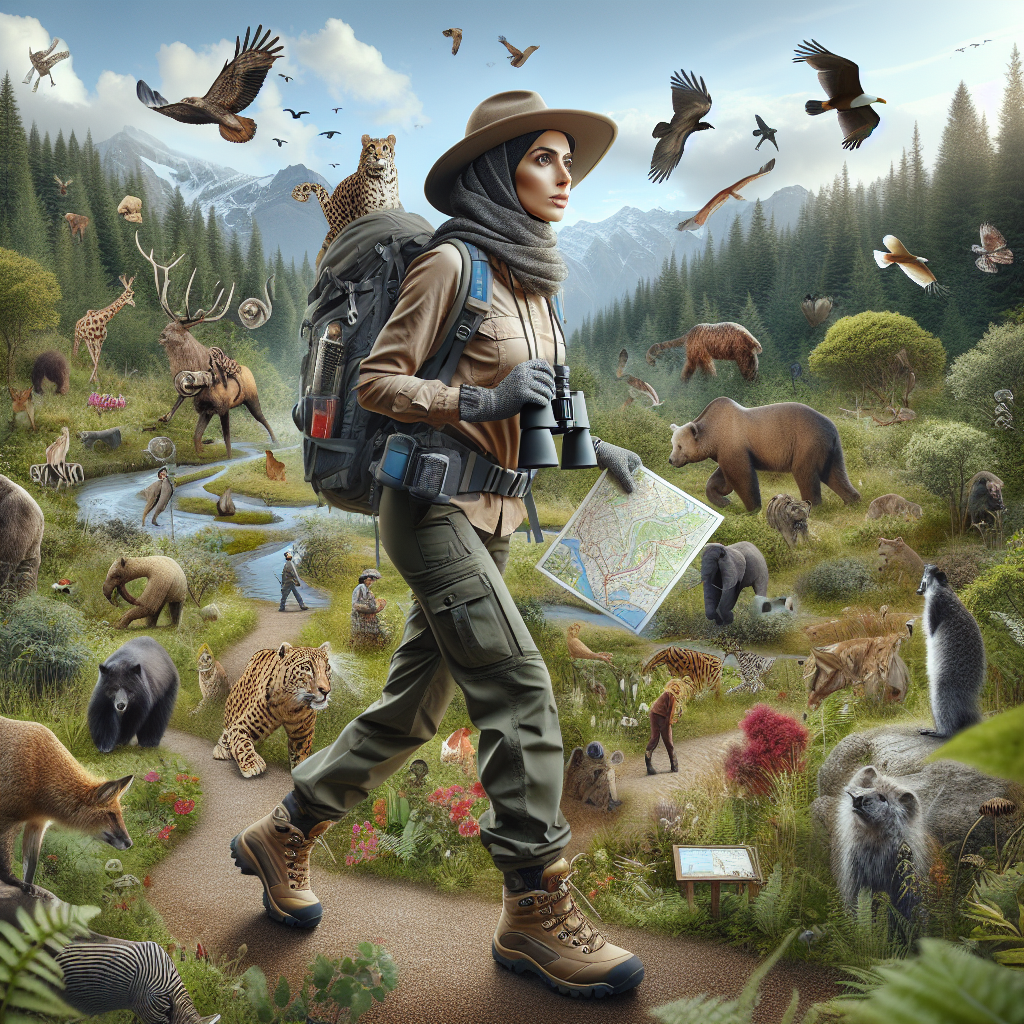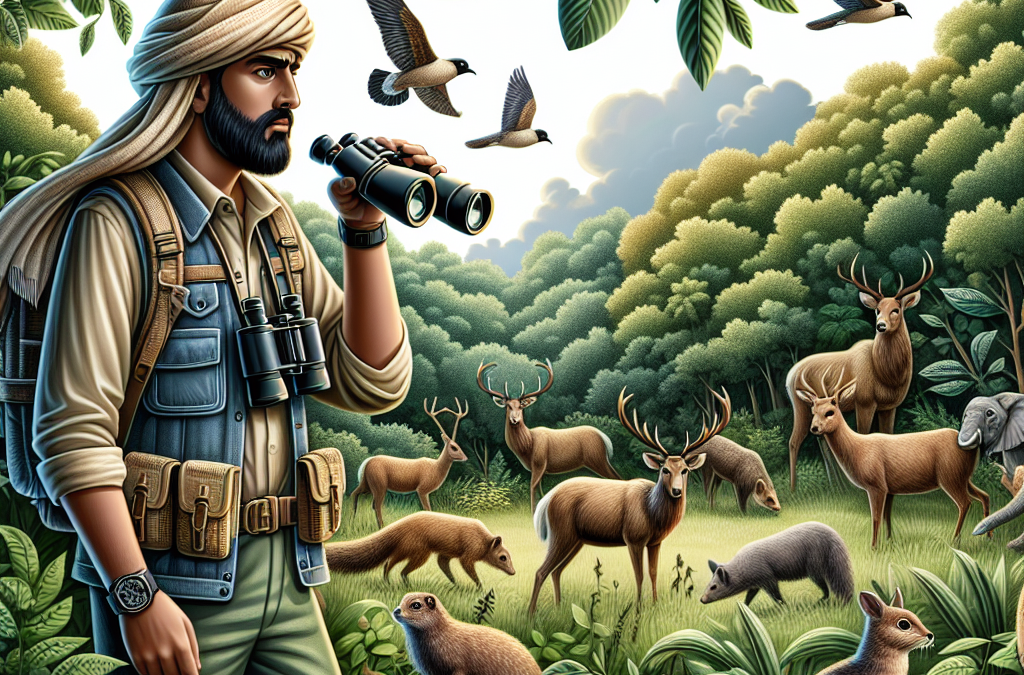Embarking on a thrilling hike soon? Let’s make it even more exciting! “Wildlife Spotting on Hikes: A Guide to Animal Encounters” is an engaging resource tailored just for you. Filled with insightful tips and tricks, it will transform your hiking trips into unforgettable wildlife-spotting adventures. Learn how to spot elusive creatures, safely observe their behavior, and understand their habits. Prepared with expert guidance, you’ll not only enrich your outdoor experience but also develop a profound appreciation for our co-inhabitants of the Earth. So, gear up for a journey that promises a beautiful blend of adrenaline and tranquillity, with exotic encounters awaiting in the wilderness.

Gear Required for Wildlife Spotting on Hikes
When you embark on a hiking adventure, being well-prepared is critical. You might not be sure what you’ll encounter during your hike, especially when dealing with wildlife. The right gear can make the experience enjoyable, safe, and also give you a chance to capture memorable moments.
Choosing the Right Binoculars
A good pair of binoculars is your key to unlocking the world of distant animals. It’s crucial to choose binoculars that are not only strong in magnification but also durable for outdoor use. Binoculars with a wide field of view can help you spot small or fast-moving creatures, while those with good close focus capability can assist in spotting bugs and birds in closer proximity. This tool will become your best friend as you’ll see details you would otherwise miss!
Importance of a Good Hiking Camera
A camera is more than just an instrument to record your journey; it’s your canvas to capture the beauty of wildlife in its natural habitat. Make sure your camera is high-resolution, has good focus capabilities, and is sturdy enough to withstand the rugged environment of hiking. Additionally, consider a model with a high zoom feature, so you can capture close-ups without disturbing or frightening your creature subjects.
Essentiality of a Compass and Map
It’s easy to become lost or disoriented in the wild, especially when you’re busy spotting wildlife. a compass and detailed hiking map are essential tools, aiding navigation and keeping you on course. They will also help ensure you can safely retrace your steps back to starting point.
Comfortable Outdoor Clothing and Footwear
Smart clothing choices go a long way in ensuring comfort during your hiking trip. Opt for lightweight but sturdy clothing and footwear to protect you from weather elements and the rough terrain while also allowing ease of movement. Don’t forget a hat and sunglasses to keep you shielded from the sun’s blazing rays!
Safety Gear: First Aid Kits and Whistles
Don’t underestimate the potential hazards on a hiking trail. A well-equipped first aid kit is a must-have for treating small injuries, insect bites or stings. Additionally, a whistle can be useful for alerting your hiking partners in case you get separated, or need help.
Learning Animal Behavior and Signs
Knowledge of animal behavior can help you spot wildlife more effectively. This involves understanding their routines, knowing what sounds they make, recognizing marks they leave behind, and being aware of their living habitats.
Understanding Animals’ Daily Routines
Every animal has a pattern that dictates its daily life. Some animals are diurnal, active during the day, while others come alive at night. Knowing these patterns will allow you to plan your hike to coincide with the times the animals you want to see are most likely to be active.
Recognizing Animal Noises
Each animal makes unique sounds, and recognizing these sounds can often give you a clue about an animal’s presence before you can see it. Be it the call of a bird, the rustling of a squirrel, or the howl of a wolf – tune your ears to these natural soundtracks.
Interpreting Animal Tracks and Marks
Animals leave behind tell-tale signs of their presence. These can include footprints, fur, scat, scratch marks on tree trunks, and more. Learning to identify these signs can transform your hiking experience, making you a detective on the trail of a creature’s path.
Reading Animals’ Body Languages
Watch for signs of animal body language. Some animals show visible signs when they feel threatened, while others display certain behaviors when they are on the hunt. By learning and understanding these behaviors, you can avoid disturbing animals or putting yourself at risk.
Awareness of Animals’ Habitats and Dens
Knowing where wildlife live, sleep, breed and feed, can help you locate them. Different species prefer different habitats such as under rocks, tall trees, burrows, or even water bodies. By respecting these places, you’re more likely to have successful wildlife sightings.
Approaching Animals Safely on Hikes
Seeing a wild animal on a hike can be very exciting, but remember, your safety and that of the animal is paramount. It’s important to maintain a respectful distance and try not to alert or agitate the creatures.
Maintaining Respectful Distance
Stay at a safe and respectful distance. Not only does this ensure the animal doesn’t feel threatened or startled, but it also prevents you from getting into dangerous situations.
Avoiding Direct Eye Contact
Many animals perceive direct eye contact as a threat. It is crucial to look away or look at the animal indirectly without making it uncomfortable.
Steps to Retreat if an Animal Feels Threatened
If you notice signs of distress in an animal, it’s time to back off. Slowly and quietly retreating shows the animal that you are not a threat.
Appropriate Noise Levels While Hiking
While it’s important to make your presence known in bear habitats, silence or soft conversation can often lead to a magical wildlife sighting. Keep noise levels low and listen to the sounds of nature.
Encountering Different Types of Animals
While hiking, you may encounter various types of animals. From birds perched on treetops to mammals scurrying in the underbrush – each requires a different spotting technique.
Bird Spotting Tips and Techniques
Bird watching or birding is a favorite hobby of many hikers. Birds often announce their presence with their calls and songs. Look for movement in the trees and pay attention to the silhouette, size, and behavioral characteristics to identify various species.
Identifying Various Mammal Species
Spotting mammals can be a thrilling experience on your hike. Often, you’ll first detect them through sounds or tracks. Bears, deer, or smaller mammals like squirrels and rabbits, can usually be spotted by looking for movement or color changes in the landscape.
Observing Reptiles and Amphibians
Reptiles and amphibians can often be seen basking on sunny rocks or hiding under logs and leaves. Be careful not to startle them and always respect their space, as some might be venomous.
Insect Identification and Safety
Watching insects can be fascinating. However, be aware of which insects are potentially harmful or irritating. Wearing appropriate clothing and using insect repellent can protect you from bites and stings.
Observing Aquatic Life in Hiking Routes
If your hike takes you past rivers, lakes, or streams, keep an eye out for aquatic wildlife. Ducks, fish, turtles, and even otters might be visible. Use your binoculars for a closer look, but ensure to maintain a respectful distance not to disturb their routines.

Dealing with Dangerous Wildlife
Nature isn’t always just beautiful and harmless creatures. A wild animal, especially when threatened, can be dangerous. From venomous snakes to large mammals like bears or mountain lions, you need to know how to handle such encounters.
Protecting Yourself from Potential Attacks
Learning about the wildlife in your hiking area can help prepare you for potential encounters. Always give wild animals plenty of space, keep noise levels low, hike in groups when possible, and know how to respond if an animal approaches you.
Dealing with Venomous Snakes
If you encounter a venomous snake, remain calm and slowly move away. Avoid sudden movements that might startle the snake, and never try to pick it up or handle it.
Handling Bear Sightings
Spotting a bear can be exhilarating and scary. Make your presence known by speaking in low, calm voice and slowly backing away while keeping an eye on the bear but avoiding direct eye contact.
Avoiding Insect Bites and Stings
Insects like bees, wasps, or mosquitoes can disrupt your hike with painful bites or stings. Apply insect repellent, wear long sleeves and pants, and avoid sweet-smelling perfumes that can attract insects.
Responding to Aggressive Wild Animals
Encountering an aggressive wild animal can be a frightening experience. If this occurs, make yourself look bigger, make noise, and back away slowly without turning your back on the animal. If confronted, use your whistle or bear spray, if you have it.
Legal and Ethical Aspects of Wildlife Spotting
Wildlife spotting comes with legal and ethical responsibilities. Make sure you follow any regulations set by park or protected area authorities and always respect the animals and the environment.
Legal Restrictions on Approaching Certain Animals
Some animals, such as endangered species or those with young, are legally protected and cannot be approached or disturbed. Make sure to familiarize yourself with the regulations in place in your area.
Ethical Guidelines for Interacting with Wildlife
Don’t feed wild animals, don’t make them dependent on humans, or disrupt their natural behavior. Animals must always be viewed from a safe and respectful distance.
Reporting Illegal Activities against Wildlife
If you witness illegal activities such as hunting, feeding, or harassing wildlife on your hike, report it to park rangers or local authorities.
Promoting Animal Welfare and Conservation
Remember, your goal is to watch animals in their natural habitats acting naturally. Promote and support efforts that help conserve these habitats and ensure the animals’ wellbeing.
Importance of Leave No Trace Principles
“Leave No Trace” principles are a set of ethics promoting conservation in outdoor settings. Every hiker should abide by them.
Impacts of Litter on Wildlife
Litter can have severe effects on wildlife. It can entangle animals, become accidentally ingested, or disturb natural habitats. Always dispose of your waste correctly.
Minimizing Camping Impact
When camping, choose sites with low impact on the environment. Leave plants, rocks, and trees as you found them and avoid altering the site.
Respect for Natural Resources
Respect your surroundings and conserve natural resources. This includes sticking to trails and not picking flowers or tampering with natural objects.
Food Disposal Considerations
Improper disposal of food can attract wildlife, creating dangerous situations for them and you. Always pack out what you pack in and secure your food when camping overnight.
Involving Children in Wildlife Spotting
Guiding children through wildlife spotting can be an educational and fun experience. It can instill a healthy respect for nature and its creatures in them.
Teaching Kids About Animal Safety
Help them understand the importance of not approaching wildlife and maintaining a safe distance. Teach them never to feed wild animals and explain why these rules exist.
Fun Animal Identification Activities
Make a game of spotting and identifying animals. This not only encourages them to engage with their surroundings but can also be a great educational experience.
Promoting Respect for Nature
Instill in them young the importance of caring for the environment. Teach them the principles of “leave no trace”.
Making Hiking Engaging and Educational for Kids
Hiking can be a great learning experience. Involve them in map reading, identifying plants and animals, and interpreting signs in nature.
Wildlife Spotting in Different Seasons
Each season, Spring, Summer, Autumn, and Winter, brings its unique range of wildlife to spot during your hikes.
Spotting Animals in Spring
Spring is a time of rebirth and growth. Young animals emerge, and birds return from their winter migrations, making it an exciting time for spotting wildlife.
Summer Wildlife Spotting
During the summer, animals are active, and there’s plenty of light to watch them. Be mindful, however, as some animals can be hidden away, avoiding the heat during daylight hours.
Autumn Wildlife Viewing
As animals prepare for the winter, fall can be an excellent time for observing them. Look for activity around nut-bearing trees and water sources as animals store up for colder days.
Winter Wildlife Encounters
While wildlife may seem scarce in winter, tracks are more visible in the snow, and some animals display rare behaviors, which makes spotting them more rewarding.
Reporting Your Findings
Sharing your wildlife observation can provide valuable data for local conservation efforts and invite others to join in the exploration.
Documenting Your Animal Sightings
Keep a record of the animals you spot on your hikes. Include details like location, time of day, animal behavior, and weather.
Sharing Findings with Local Wildlife Organizations
Share your sightings with local wildlife organizations. This can contribute to monitoring efforts and conservation of the local ecosystem.
Engaging with the Citizen Science Community
Join networks of nature enthusiasts who engage in “citizen science”. These communal efforts can be richly rewarding and beneficial to conservation efforts.
Benefits of Contribiting to Wildlife Studies
Your wildlife observations can help scientists track changes in animal populations and behavior. And just as importantly, your own connection with the natural world may deepen.

